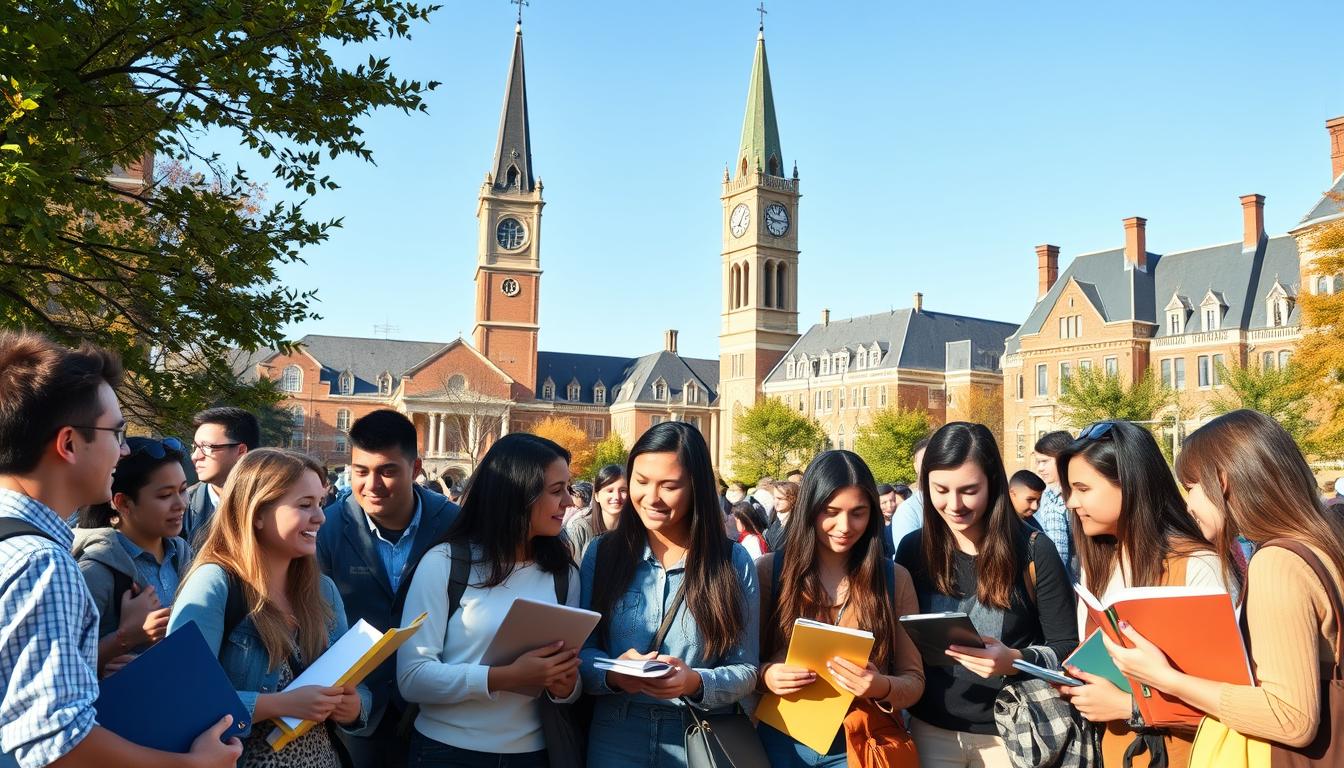Navigating US University Admissions: A Guide for International Applicants
Did you know that in 2020, over 1 million international students were enrolled in universities across the United States?
As an aspiring international student, navigating the complex process of university admissions can be daunting. The journey involves understanding various requirements, deadlines, and procedures that can vary significantly from one institution to another.
This guide is designed to walk you through the university admissions process, providing you with the necessary insights and tools to make your application stand out.
Key Takeaways
- Understanding the basics of the university admissions process
- Identifying the right university for your academic goals
- Navigating application requirements and deadlines
- Tips for a successful application
- Resources for further guidance
Understanding the US Higher Education System
For international students, grasping the nuances of the US higher education system is a critical step in choosing the right university. The US higher education system is renowned for its diversity and complexity, offering a wide range of academic programs and institutional types.
Types of Institutions: Universities vs. Colleges
In the US, the terms “university” and “college” are often used interchangeably, but there are key differences. Universities are typically larger and offer a broader range of undergraduate and graduate degree programs. Colleges, on the other hand, are usually smaller and may offer more focused programs.
Public vs. Private Institutions
US institutions can be categorized as public or private. Public institutions are funded by state governments and often have larger student bodies. Private institutions, while generally more expensive, may offer more financial aid to international students.
Degree Programs and Academic Calendar
US institutions offer various degree programs, including associate’s, bachelor’s, master’s, and doctoral degrees. The academic calendar typically follows a semester or quarter system, with most institutions starting in late summer or early fall.
Rankings and Accreditation
When choosing a US institution, consider factors like rankings and accreditation. Rankings can provide insight into an institution’s reputation, while accreditation ensures that the institution meets certain academic standards.
| Institution Type | Characteristics | Examples |
|---|---|---|
| Public Universities | State-funded, large student body | University of California, University of Michigan |
| Private Universities | Higher tuition, more financial aid | Harvard University, Stanford University |
| Liberal Arts Colleges | Smaller, focused on undergraduate education | Amherst College, Swarthmore College |
Preparing for the US University Admissions Process
As an international applicant, navigating the US university admissions process can be daunting, but with a clear understanding of the steps involved, you can approach it with confidence. The process requires careful planning, research, and attention to detail.
Creating a Timeline: When to Start
Creating a timeline is crucial for managing the application process effectively. It’s recommended to start at least 12-18 months before the intended enrollment date. This allows ample time for researching universities, preparing for standardized tests, and submitting applications.
- Research universities and programs
- Prepare for and take required standardized tests
- Collect and submit academic transcripts and letters of recommendation
- Complete and submit applications
Researching and Selecting Universities
Researching universities involves considering factors such as academic programs, location, size, and campus culture. It’s essential to find a university that aligns with your academic goals and personal preferences.
Key considerations include:
- Accreditation status
- Program curriculum and specializations
- Faculty expertise
- Campus resources and support services
Understanding Admission Requirements
Understanding the admission requirements is critical for a successful application. These requirements typically include academic transcripts, standardized test scores, and letters of recommendation.
Academic Transcripts and Credential Evaluation
International applicants must provide academic transcripts that detail their previous academic work. These transcripts may need to be evaluated by a credential evaluation service to ensure they meet US standards.
Standardized Tests (TOEFL, SAT, ACT, GRE, GMAT)
Standardized tests are a crucial component of the application process. International students may need to take English proficiency tests like TOEFL, as well as tests like SAT, ACT, GRE, or GMAT, depending on the program they’re applying to.
Letters of Recommendation
Letters of recommendation from academic or professional mentors can significantly strengthen an application. It’s essential to choose recommenders who know you well and can speak to your abilities and potential.
By understanding and adhering to these requirements, international applicants can enhance their chances of a successful application to US universities.
Crafting a Successful Application for US University Admissions
The key to a successful US university application lies in understanding the admission requirements and presenting your qualifications effectively. As you prepare your application, it’s essential to focus on several critical components that can make your application stand out.
Writing an Effective Personal Statement
Your personal statement is a crucial element of your application, providing an opportunity to share your story and highlight your unique qualities. To craft a compelling personal statement, start by brainstorming significant experiences and achievements that have shaped your academic and personal journey. Use specific examples to demonstrate your skills and passions, and ensure that your statement is well-structured and free of errors.

Showcasing Extracurricular Activities and Achievements
Extracurricular activities and achievements play a significant role in demonstrating your capabilities and commitment to your chosen field. When highlighting these activities, focus on those that showcase leadership, teamwork, and innovation. Be sure to quantify your achievements wherever possible, using metrics such as awards won, projects completed, or leadership positions held.
Preparing for Interviews
Many US universities require or offer interviews as part of the admissions process. To prepare, research common interview questions, practice your responses, and be ready to discuss your interests, goals, and experiences. It’s also essential to demonstrate enthusiasm for the university and program you’re applying to, as well as a clear understanding of how the program aligns with your aspirations.
Submitting Applications Through Common App vs. Direct Applications
US universities offer various application submission processes, including the Common App and direct applications through their websites. The Common App simplifies the process by allowing you to submit a single application to multiple participating universities. However, some institutions may require direct applications, so it’s crucial to check the specific requirements for each university on your list.
Following Up After Submission
After submitting your application, it’s a good practice to follow up with the admissions office to confirm receipt of your materials and to express your continued interest in the program. This can be done through a polite email or phone call, and it demonstrates your proactive approach and enthusiasm for the university.
By focusing on these key areas and presenting a well-rounded application, you can enhance your chances of success in the US university admissions process.
Navigating Financial Considerations
The cost of studying in the US can be daunting, but with the right information, you can make informed decisions. As an international student, understanding the financial aspects of US university admissions is crucial for planning your academic journey.
Tuition and Living Costs
Tuition fees in the US vary significantly depending on the institution type, location, and program. On average, tuition can range from $20,000 to over $50,000 per year. Additionally, living costs, including accommodation, food, and transportation, can add another $10,000 to $20,000 to your annual expenses.
To give you a better idea, here are some estimated costs:
- Tuition fees: $20,000 – $50,000 per year
- Accommodation: $8,000 – $12,000 per year
- Food and transportation: $4,000 – $8,000 per year
- Health insurance: $1,000 – $2,000 per year
Scholarships and Financial Aid for International Students
Many US universities offer scholarships and financial aid to international students. These can be merit-based, need-based, or a combination of both. It’s essential to research and explore these opportunities early in your application process.
Some popular scholarship options include:
- Merit-based scholarships
- Need-based grants
- Government-funded scholarships
- Private scholarships
Demonstrating Financial Capability
To secure a US student visa, you’ll need to demonstrate your financial capability to cover tuition and living expenses. This typically involves providing bank statements or sponsorship letters as part of your visa application.
To comply with visa requirements, ensure you have:
- Sufficient funds to cover the first year of study
- A clear understanding of your university’s tuition and living costs
- Documentation to prove your financial capability
Working While Studying: Regulations and Opportunities
International students in the US can work part-time on campus or participate in Optional Practical Training (OPT) programs. Understanding the regulations and opportunities can help you manage your finances effectively.
Key points to consider:
- On-campus employment is limited to 20 hours per week during term time
- OPT programs allow you to work off-campus in your field of study
- You must apply for an Employment Authorization Document (EAD) to work off-campus

Securing Your Student Visa and Preparing for Arrival
Navigating the process of securing a student visa can seem daunting, but with the right guidance, you’ll be well-prepared. As an international student, understanding the requirements and procedures for obtaining a student visa is crucial for a smooth transition to studying in the US.
Understanding F-1 and J-1 Visa Requirements
The US offers two primary types of student visas: F-1 and J-1. F-1 visas are for academic students, while J-1 visas are for exchange visitors, including students in non-academic programs. To apply, you’ll need to be accepted into a US university and receive a Form I-20 (for F-1) or Form DS-2019 (for J-1).
Preparing for the Visa Interview
Preparation is key for a successful visa interview. Ensure you have all required documents, including your passport, Form I-20 or DS-2019, and proof of financial support. Practice answering common interview questions, such as your reasons for choosing your university and your plans after graduation.
Pre-Departure Checklist
Before you leave for the US, make sure you have completed the following: obtained your visa, booked your flight, arranged for accommodation, and purchased health insurance. It’s also wise to register with your university’s international student office and familiarize yourself with their support services.
Cultural Adjustment and Campus Resources
Adjusting to a new culture can be challenging. Most US universities offer resources to help international students adjust, including orientation programs, cultural events, and counseling services. Don’t hesitate to reach out to these resources to make your transition smoother.
By understanding the visa process and preparing accordingly, you’ll be ready for your academic journey in the US. Remember, your university’s support staff is there to help you every step of the way.
Conclusion
As an international applicant, you’ve taken the first step towards achieving your academic goals in the US. This guide has walked you through the US university admissions process, from understanding the higher education system to securing your student visa.
You now have a clear understanding of the types of institutions, admission requirements, and financial considerations. Crafting a successful application, including a compelling personal statement and showcasing extracurricular activities, is crucial. Preparing for your visa interview and cultural adjustment will also ease your transition.
By following this guide, you’re well-equipped to navigate the complexities of US university admissions. Stay focused, and you’ll be on your way to joining the vibrant community of international students in the US.




